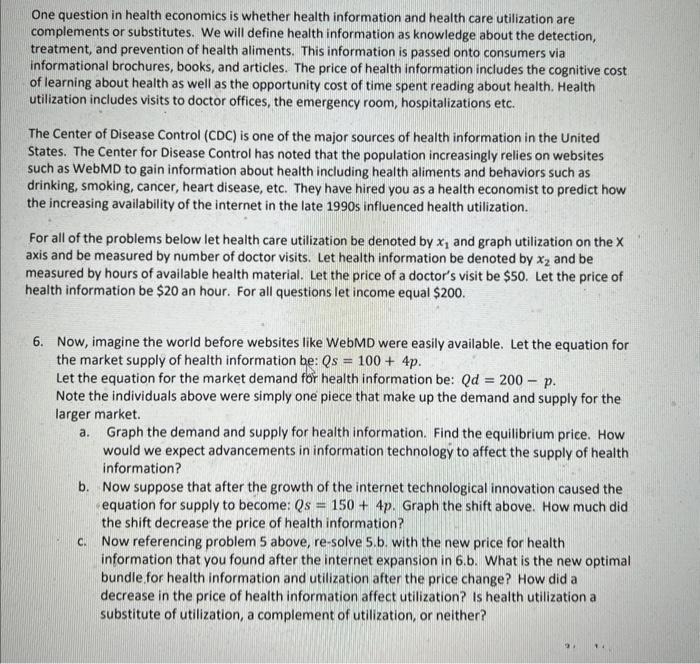One question in health economics is whether health information and health care utilization are complements or substitutes. We will define health information as knowledge about the detection, treatment, and prevention of health aliments. This information is passed onto consumers via informational brochures, books, and articles. The price of health information includes the cognitive cost of learning about health as well as the opportunity cost of time spent reading about health. Health utilization includes visits to doctor offices, the emergency room, hospitalizations etc. The Center of Disease Control (CDC) is one of the major sources of health information in the United States. The Center for Disease Control has noted that the population increasingly relies on websites such as WebMD to gain information about health including health aliments and behaviors such as drinking, smoking, cancer, heart disease, etc. They have hired you as a health economist to predict how the increasing availability of the internet in the late 1990 s influenced health utilization. For all of the problems below let health care utilization be denoted by x1 and graph utilization on the X axis and be measured by number of doctor visits. Let health information be denoted by x2 and be measured by hours of available health material. Let the price of a doctor's visit be $50. Let the price of health information be $20 an hour. For all questions let income equal $200. 6. Now, imagine the world before websites like WebMD were easily available. Let the equation for the market supply of health information be: Qs=100+4p. Let the equation for the market demand for health information be: Qd=200p. Note the individuals above were simply one piece that make up the demand and supply for the larger market. a. Graph the demand and supply for health information. Find the equilibrium price. How would we expect advancements in information technology to affect the supply of health information? b. Now suppose that after the growth of the internet technological innovation caused the equation for supply to become: Qs=150+4p. Graph the shift above. How much did the shift decrease the price of health information? c. Now referencing problem 5 above, re-solve 5 .b. with the new price for health information that you found after the internet expansion in 6.b. What is the new optimal bundle for health information and utilization after the price change? How did a decrease in the price of health information affect utilization? is health utilization a substitute of utilization, a complement of utilization, or neither? One question in health economics is whether health information and health care utilization are complements or substitutes. We will define health information as knowledge about the detection, treatment, and prevention of health aliments. This information is passed onto consumers via informational brochures, books, and articles. The price of health information includes the cognitive cost of learning about health as well as the opportunity cost of time spent reading about health. Health utilization includes visits to doctor offices, the emergency room, hospitalizations etc. The Center of Disease Control (CDC) is one of the major sources of health information in the United States. The Center for Disease Control has noted that the population increasingly relies on websites such as WebMD to gain information about health including health aliments and behaviors such as drinking, smoking, cancer, heart disease, etc. They have hired you as a health economist to predict how the increasing availability of the internet in the late 1990 s influenced health utilization. For all of the problems below let health care utilization be denoted by x1 and graph utilization on the X axis and be measured by number of doctor visits. Let health information be denoted by x2 and be measured by hours of available health material. Let the price of a doctor's visit be $50. Let the price of health information be $20 an hour. For all questions let income equal $200. 6. Now, imagine the world before websites like WebMD were easily available. Let the equation for the market supply of health information be: Qs=100+4p. Let the equation for the market demand for health information be: Qd=200p. Note the individuals above were simply one piece that make up the demand and supply for the larger market. a. Graph the demand and supply for health information. Find the equilibrium price. How would we expect advancements in information technology to affect the supply of health information? b. Now suppose that after the growth of the internet technological innovation caused the equation for supply to become: Qs=150+4p. Graph the shift above. How much did the shift decrease the price of health information? c. Now referencing problem 5 above, re-solve 5 .b. with the new price for health information that you found after the internet expansion in 6.b. What is the new optimal bundle for health information and utilization after the price change? How did a decrease in the price of health information affect utilization? is health utilization a substitute of utilization, a complement of utilization, or neither







